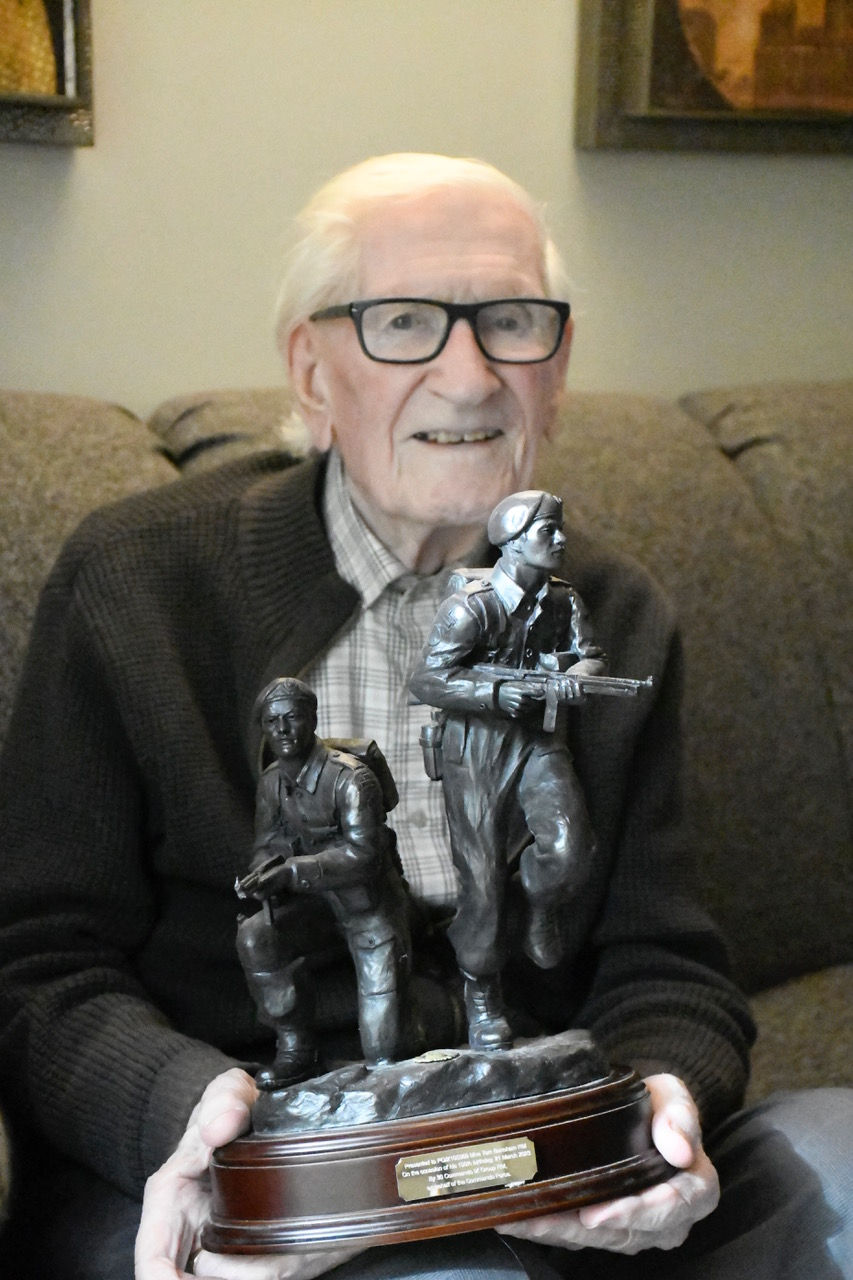Tillsonburg resident was part ofWW II secretive commando unit
- Jeff Helsdon

- Nov 14, 2024
- 4 min read

When Tom Boneham turned 100, he received a surprise visit from present-day members of Britain’s 30 Commando. They brought him a statue commemorating the unit, showing unit members in their Second World War uniforms and carrying the appropriate battle gear. Boneham’s friend Christine Grim arranged the visit. (Jeff Helsdon Photo).
By Jeff Helsdon
Imagine having a mission so secretive that those involved don’t know what they are up to until records are declassified decades later.
Sound like the stuff spy novels or movies are made from? Perhaps it seems like the fictional spy James Bond would be involved in?
This was actually Tillsonburg resident Tom Boneham’s experience during the Second World War. And there was a definite James Bond connection as the author of the famed spy novels was the commanding officer of his unit.
Boneham served in the Home Guard when he was 16 and 17 and joined the regular forces on his 18th birthday in March 1941. His father was in the Royal Marines in the First World War.
“I wanted to be in the Royal Marines, the same as dad,” Boneham, now 101, said from his Tillsonburg home. “In World War II, they were renamed the commandos. They were the original commandos.”
The concept for the formation of the commandos came from Commander Ian Fleming, the author of the James Bond series. The unit aimed to capture documents and ciphers from behind enemy lines. The unit and its operations were one of the sources of inspiration for the Bond books.
Boneham volunteered for the special intelligence unit. He was assigned to 30 Commando.
“It was so secret every time we went out, we didn’t know if we were going out for an exercise or active duty,” he said.
Although it took place before Boneham was assigned to 30 Commando, the group took part in the Dieppe raid, with an assignment to capture the Enigma code book to allow the British to decode the German communications.
“The first thing they knew they were in action was when the guns in Dieppe were turned on them,” Boneham said.
The group didn’t succeed in that mission but went on to others.
Training was vigorous for 30 Commando members. Boneham said they trained with live ammunition. He recounted one exercise where they had to scale the exterior of a bombed building in London, go through the window, and then be ready for an ambush from training officers. In another exercise, they had to go down the cliffs at the Isle of Wight, where they were training, with only a loop in a rope to suspend them. In other instances, they had to cross a beach with tracer fire in front and behind them.
Although he didn’t have details, Boneham knew that in his unit, there was an expert in safe blowing, another who was a photographer, and a third who was good with sledgehammers. Instead of the barracks typical for military personnel, 30 Commando members had private lodgings, so they did not talk to each other.
After a short stint in Algiers for training, Boneham and the 30 Commando were sent to Sicily to get intelligence from the Italian and German headquarters. His first job was to get the ID off his own troops who were wounded. Boneham didn’t make it to shore as part of the intelligence gathering portion of the mission because he was wounded, receiving a bullet through the shoulder.
“All of a sudden, something hit me from behind. My arm was paralyzed,” he said of what occurred. The next thing he knew he woke up in a Jeep being taken to a field hospital.
Years later he would learn he was wounded by one of his own accidentally through the 30 Commando museum.
After a lengthy hospital stay, Boneham went to the University of South Hampton to train in electronics. Unsatisfied with the wages, economy, and politics in England, he and a friend were going to move to Australia, but when they found obstacles to that plan, they settled on Canada. When Boneham arrived in Canada in 1952, he had $25 in his pocket. He settled in Toronto, married, and worked for R.H. Nichols Co., which manufactured instruments for planes and the space program. He didn’t have children, and after his second wife passed away, he became friends with Christine Grim, who owned the attached house next door and helped him. When Grim decided to move to Tillsonburg in 2013, Boneham was getting up in years and would have had to go to a retirement home. She presented him with an alternative: move to Tillsonburg and have his own space in her house.
Books written about the 30 Commando after most, but not all, of their information was declassified 60 years later provided Boneham with more insight into what the unit was doing than he was told when living it.
Boneham knew Fleming was the unit's commanding officer and was positive he had met him. The issue was that when the commanding officers visited, it was under a shroud of secrecy. The men in the unit never knew the names of those who were visiting them.
“I know I met him by remarks in this book, putting myself back to what was said at the time,” Boneham said.
He suspects he met Fleming in Sicily, where he was in charge of food for members of the 30 Commando who were staying in a farmhouse. Boneham provided an officer with food, and with Fleming being upper society, he suspects it was him from remarks made.




Comments